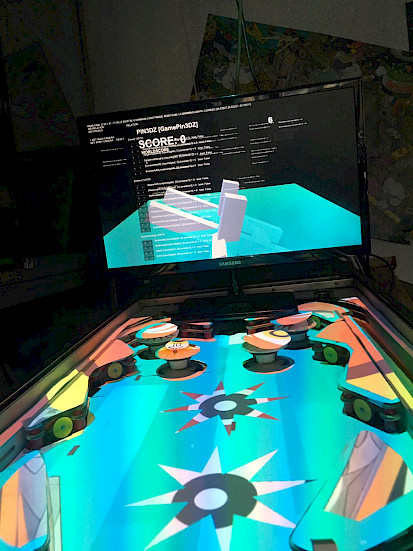PinballZ - Pinball controlled by a GameEngine and 3D mapping
Pinballs are actually very static machines. Their basic setting is set from the very beginning: They work mostly with fixed setups (obstacles, things you can hit, paths). Their dynamics evolve through lighting and the possibility to change their real level design. Be it with blocks that can be clicked into place or, from the 80's onwards, by means of motors and servos.
__
PinballZ – Flipper gesteuert von einer GameEngine und 3D-Mapping
Pinballs sind eigentlich sehr statische Maschinen. Ihr Grundsetting steht von Anfang an: Sie arbeiten mehrheitlich mit festen Aufbauten (Hindernissen, Dinge, die man Treffen kann, Bahnen). Ihre Dynamik entwickelt sich über die Beleuchtung und die Möglichkeit ihr reales Leveldesign zu ändern. Sei es mit einklabbaren Blöcken oder ab den 80er Jahren mittels Motoren und Servos.

First version - basis is an electromechanical pinball machine
Erste Version - Grundlage ein elektromechanischer Flipper
The gameplay is as simple as it is fascinating: play the ball against gravity using two pinball fingers. Every shot is a kind of duel (do you hit what you want or not) and depends on the skill and the analog physics. Whereby sooner or later gravity will win.
__
Das Gameplay ist dabei so simpel wie faszinierend: Spiel den Ball gegen die Schwerkraft mittels zwei Flipperfinger. Dabei ist jeder Schuss eine Art Duell (trifft man das Gewollte oder nicht) und abhängig vom Geschick und der analogen Physik. Wobei über kurz oder lang die Schwerkraft gewinnen wird.
#supermarios #mushrums balls for ken on #pinballZ pic.twitter.com/NKIEKG6VBx
— electric sheep (@ixistenz) December 13, 2016
The PinballZ project adopts this logic, leaving the unbeatable analog physics (doesn't emulate them) and the given setting in place, but makes the display dynamic by 'whitening' the surface of a pinball machine and playing on it via 3D mapping. This creates a much more freely playable surface.
It is now possible to directly include films or videos, to fundamentally change the setting, to introduce only virtual elements.
__
Das PinballZ-Projekt nimmt sich dieser Logik an und belässt die unschlagbare analoge Physik (emuliert sie nicht) und das vorgegebene Setting, macht aber das Display dynamisch, indem es die Oberfläche eines Flippers 'weisselt' und per 3D-Mapping bespielt. Dadurch entsteht eine viel freier bespielbare Oberfläche.
Es ist nun möglich direkt Filme einzubeziehen, das Setting grundlegend zu ändern, nur virtuelle Elemente einzuführen.
##pinballZ.yellowbox - everything is just a projection .) ##swissgames @gamezfestival @FLIP_org @frescogamba #arduino ##unity3d @Polygon pic.twitter.com/xtA5UC9ehf
— electric sheep (@ixistenz) November 11, 2017
The electronic/digital control technology of the pinball machine was completely removed and equipped with appropriate inputs/outputs by a computer. The whole control and the visuals are done by the game engine UNITY. The pinball machine was rebuilt (tracks laid out differently) so that it became more playable in its basic layout.
__
Die elektronische/digitale Controlltechnik des Flippers wurde vollständig entfernt und durch einen Computer mit entsprechenden Input/Outputs versehen. Die Gesamte Steuerung und die Visuals übernimmt die Game Engine UNITY. Der Flipper wurde umgebaut (Bahnen anders angelegt), so dass er in seiner Grundanlage spielbarer wurde.
ball at the gates! ##pinball ##flipper ##pinballZ ##bullethell ##swissgames pic.twitter.com/nWNXJccpep
— electric sheep (@ixistenz) September 8, 2017
Findings and problems:
- A pinball is more complex than it looks because it is situated in the analog. For example, the balls sometimes skip a lane, etc.
- A pinball is a machine! Things break, it needs maintenance.
- A pinball is a very fast mechanical machine.
- The number of sensors behind the game mechanics is immense (60+). The number of outputs in the original pinball machines is also enormous (lights).
- The IO cards were partly too slow (Phidget) for the pinball (ball speed partly over 100km/h), so own circuits had to be developed – or for the light barrier an Arduino was used, which extended the contact times of e.g. bumpers or shoot targets.
- A pinball finger has two windings: one for shooting and one for holding.
- Programming errors can quickly lead to serious failures: For example, a pinball coil melted due to a programming error.
- Power supply: The pinball machine needs a power supply that delivers up to 6 AMP for 12 volts!
- Cascaded pinball fingers (such as two-story pinball machines) must be connected in series, otherwise the "current" is not enough.
––
Resultate & Probleme:
- Ein Pinball ist komplexer, als es aussieht, weil sie im Analogen situiert ist. Die Bälle überspringen etwa manchmal eine Bahn etc.
- Ein Pinball ist eine Maschine! Dinge gehen kaputt, sie muss gewartet werden.
- Ein Pinball ist eine sehr schnelle mechanische Maschine.
- Die Anzahl der Sensoren hinter der Spielmechanik ist immens (60+). Die Anzahl Outputs in den Orginal-Flippern ist auch enorm (Lämpchen).
- Die IO-Karten waren teilweise zu langsam (Phidget) für den Flipper (Ballgeschwindigkeit teilweise über 100km/h), so mussten eigene Schaltkreisläufe entwickelt werden bzw. für die Lichtschranke wurde eine Arduino eingesetzt, das die Kontakzeiten etwa von Bumpers oder Shoot-Targets verlängert hat.
- Ein Flipperfinger hat zwei Wicklungen: eine zum Schiessen und eine zum Halten.
- Programmierfehler können schnell zu schwerwiegenden Fehlern führen: So zerschmolz etwa ein Flipper-Coil durch einen Programmierfehler.
- Stromzufuhr: Der Flipper braucht eine Stromzufuhr, die bis zu 6 AMP liefert für 12 Volt!
- Kaskadierte Flipperfinger (etwa bei zweistöckigen Flippern) müssen seriell geschaltet werden, sonst reicht der "Strom" nicht.


